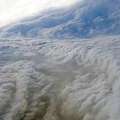 一份針對北大西洋颶風和熱帶暴風雨所進行的最新統計分析顯示,1995年到2005年期間,每年在大西洋形成的颶風數量,是100年前的2倍。研究人員推斷,由於氣候變遷導致海面溫度升高以及風向改變,是颶風數量增加的主要因素。
一份針對北大西洋颶風和熱帶暴風雨所進行的最新統計分析顯示,1995年到2005年期間,每年在大西洋形成的颶風數量,是100年前的2倍。研究人員推斷,由於氣候變遷導致海面溫度升高以及風向改變,是颶風數量增加的主要因素。
此份由美國國家大氣研究中心研究員霍蘭德,以及喬治亞理工學院韋伯斯特教授共同進行的研究,30日在英國皇家學院網站正式發表。
美國國家海洋暨大氣總署科學家預測,2007年大西洋颶風季節會有13至17個暴風形成,其中7到10個會轉變為颶風,3到5個可能形成3級以上的強烈颶風,而過去大西洋颶風季節平均約有11個暴風,6個轉為颶風形態,其中2個則轉為強烈颶風。
暴風形成次數急速增加的前幾年,也是海平面溫度開始產生變化的時間,在1930年時海面溫度上升華氏0.7度,1995年溫度再次升高,並持續上升。
此份研究也指出,大自然的循環週期有可能不是颶風次數增加的主要原因,因為這種頻繁現象是發生在過去100年內,而不是在自然循環週期中逐漸增加。
Twice as many Atlantic hurricanes formed each year from 1995 to 2005, on average, than formed during parallel years a century ago finds a new statistical analysis of hurricanes and tropical storms in the north Atlantic. The researchers conclude that warmer sea surface temperatures and altered wind patterns associated with global climate change are responsible for the increase.
The study, by Greg Holland of the National Center for Atmospheric Research, NCAR, and Peter Webster of Georgia Institute of Technology, is published online today by the Royal Society of London.
For the 2007 Atlantic hurricane season, NOAA scientists predict 13 to 17 named storms, with seven to 10 becoming hurricanes, of which three to five could become major hurricanes of Category 3 strength or higher. An average Atlantic hurricane season brings 11 named storms, with six becoming hurricanes, including two major hurricanes.
The changes in sea surface temperatures took place in the years before to the sharp increases in storm frequency, with an sea surface temperature rise of 0.7 degrees Fahrenheit leading up to 1930 and a similar rise leading up to 1995 and continuing even after.
The Holland and Webster study indicates that natural cycles are probably not the entire cause of the increase in hurricane numbers because the increase has happened across the last century rather than oscillating in tandem with a natural cycle.
全文及圖片詳見 ENS







